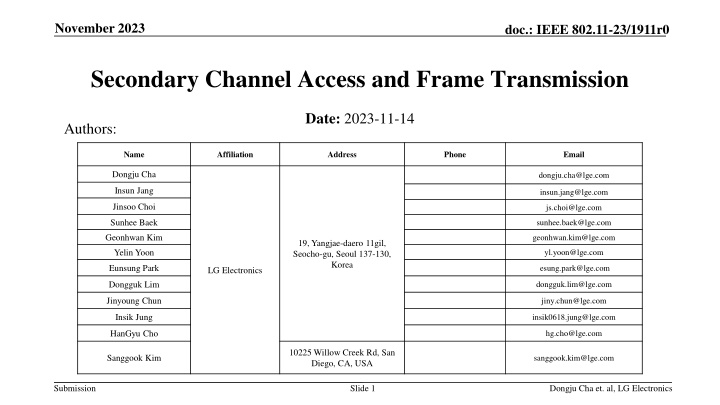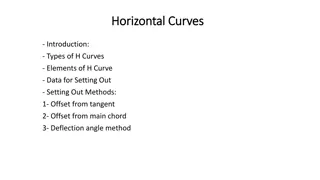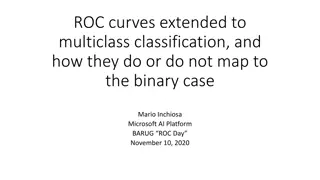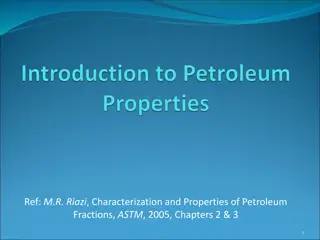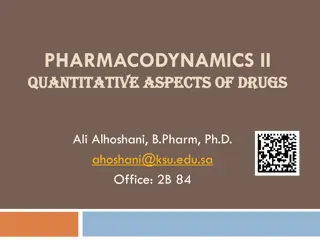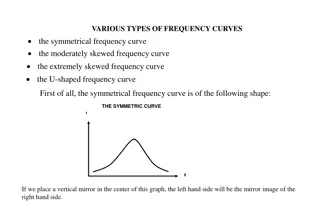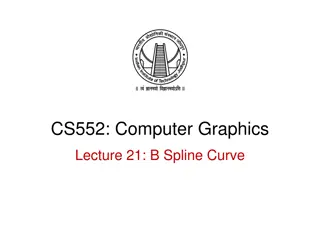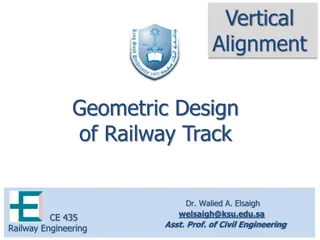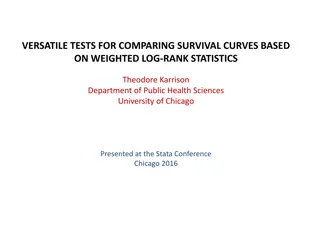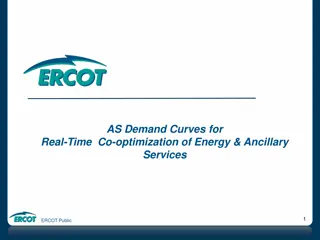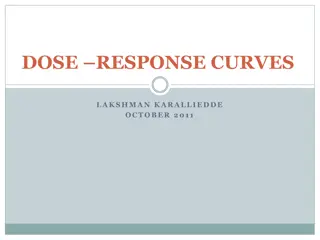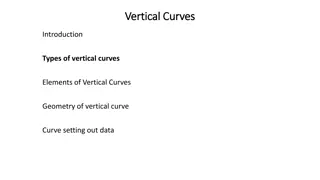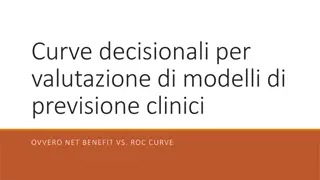Area Between Two Curves
Review and extend the use of definite integrals for representing plane areas. Learn how to calculate the total area bounded by curves and the x-axis, integrating absolute values for positive area. Explore examples to compute areas between curves and the x-axis over given intervals step by step.
Download Presentation

Please find below an Image/Link to download the presentation.
The content on the website is provided AS IS for your information and personal use only. It may not be sold, licensed, or shared on other websites without obtaining consent from the author.If you encounter any issues during the download, it is possible that the publisher has removed the file from their server.
You are allowed to download the files provided on this website for personal or commercial use, subject to the condition that they are used lawfully. All files are the property of their respective owners.
The content on the website is provided AS IS for your information and personal use only. It may not be sold, licensed, or shared on other websites without obtaining consent from the author.
E N D
Presentation Transcript
November 2023 doc.: IEEE 802.11-23/1911r0 Secondary Channel Access and Frame Transmission Date: 2023-11-14 Authors: Name Affiliation Address Phone Email Dongju Cha dongju.cha@lge.com Insun Jang insun.jang@lge.com Jinsoo Choi js.choi@lge.com Sunhee Baek sunhee.baek@lge.com Geonhwan Kim geonhwan.kim@lge.com 19, Yangjae-daero 11gil, Seocho-gu, Seoul 137-130, Korea Yelin Yoon yl.yoon@lge.com Eunsung Park esung.park@lge.com LG Electronics Dongguk Lim dongguk.lim@lge.com Jinyoung Chun jiny.chun@lge.com Insik Jung insik0618.jung@lge.com HanGyu Cho hg.cho@lge.com 10225 Willow Creek Rd, San Diego, CA, USA Sanggook Kim sanggook.kim@lge.com Submission Slide 1 Dongju Cha et. al, LG Electronics
November 2023 doc.: IEEE 802.11-23/1911r0 Introduction In 802.11, many contributions have been discussed to improve the use of the medium E.g., DL/UL MU based on MU-MIMO/OFDMA with preamble puncturing However, frame exchange is allowed only when primary channel is IDlE even when the remaining secondary channels are available which limits the efficient use of the medium So, in previous UHR SG, we have discussed secondary channel access (or, non-primary channel access) that allows frame exchange even when primary channel is BUSY [1][2] In this contribution, we discuss the operation of secondary channel access and some technical issues and solutions to achieve successful frame exchange when performing secondary channel access mechanism Submission Slide 2 Dongju Cha et. al, LG Electronics
November 2023 doc.: IEEE 802.11-23/1911r0 Recap: Wide Bandwidth Channel Access According to the current spec, primary channel (PCH) is the only channel that can perform Back-off procedure and frame exchange cannot be happened when PCH is BUSY even though the remaining secondary channel(s) (SCH(s)) is IDLE This limits the efficient use of the medium in wide bandwidth operation New mechanism that allows frame exchange even when PCH is BUSY needs to be defined in 802.11bn for the medium efficiency Submission Slide 3 Dongju Cha et. al, LG Electronics
November 2023 doc.: IEEE 802.11-23/1911r0 Overview: Secondary Channel Access Operation When PCH cannot be used due to a Basic NAV, STA may switch to SCH to perform Back-off procedure Switching to SCH is allowed only when PCH is BUSY due to the Basic NAV Switching to SCH when intra-BSS NAV is set on PCH is not proper since AP and STA are currently exchanging frames When BC on an SCH for BO reaches to 0, a PPDU including Frame(s) can be transmitted on other IDLE SCH(s) including SCH for BO After frame exchange is done through Secondary Channel Access (SCA), STA switches to PCH Submission Slide 4 Dongju Cha et. al, LG Electronics
November 2023 doc.: IEEE 802.11-23/1911r0 Prerequisites for Secondary Channel Access Operation SCA Capabilities STAs can have several capabilities for performing SCA Capability for supporting SCA Capability for Sequential PD/CCA vs. Concurrent PD/CCA SCA related parameters shall be announced by an AP One or more SCH(s) for Back-off To perform SCA, at least one SCH for Back-off shall be announced Each SCH(s) for Back-off is one of 20MHz channel in its BSS Operating Channel Width When having multiple SCHs for Back-off, STA may get more gain in terms of channel access delay or channel access opportunity EDCA Parameter Set for SCH(s) E.g. EDCA Parameter Set for PCH can be shared with SCH while updating its own CW parameter Or, New EDCA Parameter for SCH(s) may be defined reusing the format of existing EDCA Parameter Set Medium Synchronization (e.g., Duration, ED threhsold, Maximum number of TXOPs) Submission Slide 5 Dongju Cha et. al, LG Electronics
November 2023 doc.: IEEE 802.11-23/1911r0 SCA Enabled Indication STA(s) supporting SCA shall perform SCA when Basic NAV is set on PCH may not be appropriate in some cases as follows, When all STA(s) associated with AP supporting SCA do not support SCA, AP should not perform SCA Some STA(s) supporting SCA may not want to switch to SCH for purpose of power saving SCA enabled/disabled indication AP and STA(s) supporting SCA indicate whether it enables SCA or not With this, prevent STA and AP from performing unnecessary SCA When AP indicates SCA indication to be disabled, STA(s) does not switch to SCH for performing SCA When AP indicates SCA indication to be enabled, STA(s) may indicate to be enabled or disabled according to STA(s) intention In case of all associated STA(s) indicates SCA indication to be disabled or does not support SCA, AP should not switch to SCH Submission Slide 6 Dongju Cha et. al, LG Electronics
November 2023 doc.: IEEE 802.11-23/1911r0 Synchronization Issues Synchronization issues should be considered Medium synchronization: When AP or STA switches to SCH for Back-off, it would lose the medium synchronization Timing issue: AP and STA may have different view on PCH E.g., AP is performing Back-off on the SCH(s) due to Basic NAV set on PCH while STA is still on PCH Solution To deal with issues above, we can design similar to medium access recovery procedure in 11be [3] Timer countdown starts after STA switches to SCH While the timer is running, STA can perform EDCA using baseline with some restrictions Considering PCH of OBSS may be overlapped with SCH for Back-off, AP needs to carefully consider the ED threshold Frame exchange shall be initiated with short control frame (e.g., RTS frame) To check whether the recipient STA is ready for frame exchage Subtype of control frame is TBD Maximum number of TXOPs that STA is allowed to attempt to initiate frame exchange can be announced by AP Submission Slide 7 Dongju Cha et. al, LG Electronics
November 2023 doc.: IEEE 802.11-23/1911r0 Different Channel Switch Time / TXOP on SCH Different channel switch time between AP and STA(s) should be considered When AP or STA switches to SCH to perform SCA, frame exchange may not be successful due to different channel switch time between AP and STA(s) E.g., STA that has done switching transmits frame to the STA that has not switched yet To address the issue above, AP and STA need to indicate their channel switch time Channel switch time from PCH to SCH, vice versa TX STA need to consider channel switch time of RX STA when transmitting frame TXOP on SCH should be end before the Basic NAV timer expires When Basic NAV timer expires, legacy STA(s) may get chance to transmit frame through PCH If frame exchange through SCA cannot be done before the Basic NAV timer expires, STA should not perform SCA When considering channel switch time, TXOP on SCH should be end before Basic NAV end time channel switch time (From SCH to PCH) Submission Slide 8 Dongju Cha et. al, LG Electronics
November 2023 doc.: IEEE 802.11-23/1911r0 Conclusion In this contribution, we ve shared some thoughts to achieve secondary channel access in 11bn in terms of Prerequisites for Secondary Channel Access Operation SCA Capability AP Announcement for SCA Related Parameters Technical Issues and Solutions Medium Synchronization/Timing issue Different Channel Switch Time TXOP on SCH Submission Slide 9 Dongju Cha et. al, LG Electronics
November 2023 doc.: IEEE 802.11-23/1911r0 Reference [1] 23/1112r0, Thoughts on Secondary Channel Access [2] 23/034r1, Non-primary Channel Utilization [3] 20/1009r10, Blindness issue for non-STR operations-followup Submission Slide 10 Dongju Cha et. al, LG Electronics
November 2023 doc.: IEEE 802.11-23/1911r0 Straw Poll 1 Do you support to define a Secondary Channel Access (SCA) which allows transmission without including primary channel in 11bn? Submission Slide 11 Dongju Cha et. al, LG Electronics
November 2023 doc.: IEEE 802.11-23/1911r0 Straw Poll 2 Do you agree that an AP supporting Secondary Channel Access announces at least one secondary channel that performs EDCA The secondary channel is one of 20MHz channel in its BSS Operating Channel Width More than one secondary channel that performs EDCA is TBD Detailed signaling is TBD Submission Slide 12 Dongju Cha et. al, LG Electronics
November 2023 doc.: IEEE 802.11-23/1911r0 Straw Poll 3 Do you agree that STA(s) supporting Secondary Channel Access indicates its channel switch time that is required when STA(s) switches from primary channel to secondary channel How to indicate is TBD Submission Slide 13 Dongju Cha et. al, LG Electronics
November 2023 doc.: IEEE 802.11-23/1911r0 Straw Poll 4 Do you agree that STA(s) supporting Secondary Channel Access indicates its channel switch time that is required when STA(s) switches from secondary channel to primary channel How to indicate is TBD Submission Slide 14 Dongju Cha et. al, LG Electronics
November 2023 doc.: IEEE 802.11-23/1911r0 Straw Poll 5 Do you agree that TXOP on secondary channel shall end before the Basic NAV timer on primary channel expires Submission Slide 15 Dongju Cha et. al, LG Electronics
November 2023 doc.: IEEE 802.11-23/1911r0 Straw Poll 6 Do you agree that a STA which performs EDCA on secondary channel shall complete switching to primary channel before the Basic NAV timer on primary channel expires Submission Slide 16 Dongju Cha et. al, LG Electronics
November 2023 doc.: IEEE 802.11-23/1911r0 Straw Poll 7 Do you agree that STA(s) supporting Secondary Channel Access initiates frame exchange with control frame when it performs EDCA on secondary channel Subtype of control frame is TBD Submission Slide 17 Dongju Cha et. al, LG Electronics
